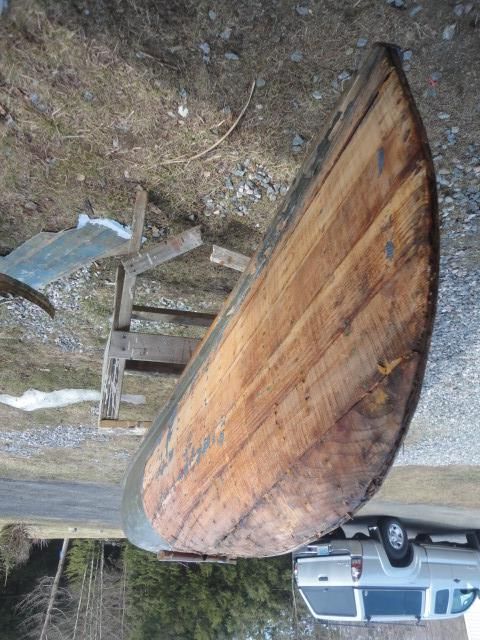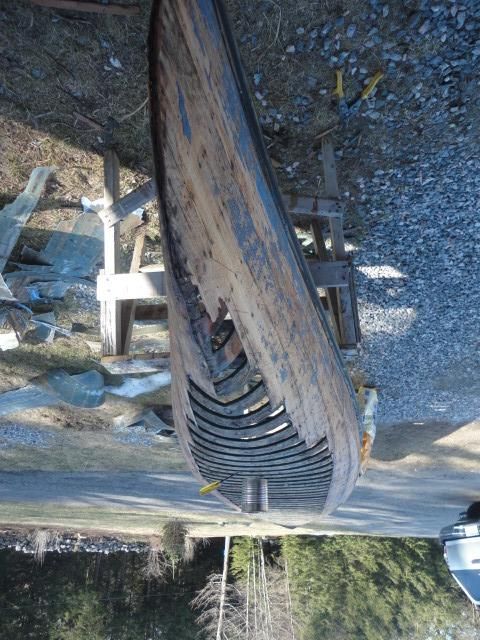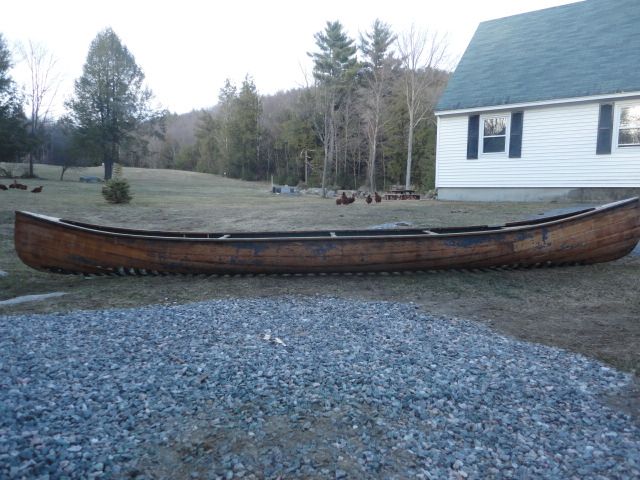This may take a while, but I figured it would be nice to share this rebuild. In a previous post, I mentioned I picked up two wood canvas canoes in the Boston area. They where free and we all know what that means, nobody else wanted them.
Well, I started working on the Kennebec right away, pretty much cause it was fiber-glassed and at 18' it was too heavy for me to lift up into the barn loft for storage.
Before I get into that, here's some information that was supplied by the Wooden Canoe Heritage Association about this canoe from files on record in Maine.
Kennebec Canoe with serial number 15604 is shown on page 273 of volume number three in the Kennebec ledgers. This was assigned to an 18.5 foot long Kennebec Guides Model. It was planked by Cameron on December 17th, 1921. The canvas covering and first filler coat were applied by Tuttle on the same day. It had no keel and the rails where applied by Clifford on March 29th, 1924. The original color was green and it was shipped to location "24-106" on April 17, 1924.
So late this afternoon I put the canoe up on horses and with a claw hammer and pair of carpet stretcher pliers I went to work on the fiberglass. Much to my surprise, it started coming off easier than a skin on a Clementine tangerine, leaving very little resin stuck to the cedar planks

The plank on the bottom of the canoe was very brittle and dry rotted, but it stayed in place.

I considered myself lucky and after all the fiberglass was removed, I went to work on the rotted plank. I then removed all the old tacks left in the ribs with my little handy tack puller shown here. I thought about Mr Cameron hammering those tacks thru the plank and into the ribs almost 90 years ago.

Lots of fiberglass for the landfill.

Left over resin on some of the plank is an issue, but it could have been alot worse.

I'm not sure what's next for this canoe, I have other projects ahead of it, so it might be gently stored till it's turn. I'll pick up where I'm leaving off soon.

Well, I started working on the Kennebec right away, pretty much cause it was fiber-glassed and at 18' it was too heavy for me to lift up into the barn loft for storage.
Before I get into that, here's some information that was supplied by the Wooden Canoe Heritage Association about this canoe from files on record in Maine.
Kennebec Canoe with serial number 15604 is shown on page 273 of volume number three in the Kennebec ledgers. This was assigned to an 18.5 foot long Kennebec Guides Model. It was planked by Cameron on December 17th, 1921. The canvas covering and first filler coat were applied by Tuttle on the same day. It had no keel and the rails where applied by Clifford on March 29th, 1924. The original color was green and it was shipped to location "24-106" on April 17, 1924.
So late this afternoon I put the canoe up on horses and with a claw hammer and pair of carpet stretcher pliers I went to work on the fiberglass. Much to my surprise, it started coming off easier than a skin on a Clementine tangerine, leaving very little resin stuck to the cedar planks

The plank on the bottom of the canoe was very brittle and dry rotted, but it stayed in place.

I considered myself lucky and after all the fiberglass was removed, I went to work on the rotted plank. I then removed all the old tacks left in the ribs with my little handy tack puller shown here. I thought about Mr Cameron hammering those tacks thru the plank and into the ribs almost 90 years ago.

Lots of fiberglass for the landfill.

Left over resin on some of the plank is an issue, but it could have been alot worse.

I'm not sure what's next for this canoe, I have other projects ahead of it, so it might be gently stored till it's turn. I'll pick up where I'm leaving off soon.

